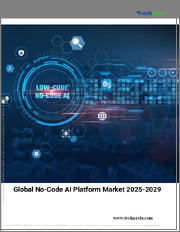
|
시장보고서
상품코드
1677903
로우코드 개발 플랫폼 시장 규모, 점유율, 성장 분석 : 컴포넌트별, 애플리케이션 유형별, 유형별, 조직 규모별, 업계별, 지역별 - 산업 예측(2025-2032년)Low-code Development Platform Market Size, Share, and Growth Analysis, By Component (Platform, Solution), By Application Type (Web-Based, Mobile-Based), By Type, By Organization Size, By Industry, By Region - Industry Forecast 2025-2032 |
||||||
로우코드 개발 플랫폼 시장 규모는 2023년에 286억 달러로, 예측 기간(2025-2032년)의 CAGR은 27.4%로, 2024년 364억 4,000만 달러에서 2032년에는 2,528억 7,000만 달러로 성장할 전망입니다.
세계 소셜미디어 참여와 산업의 급속한 디지털화가 시장 확대의 원동력이 되고 있으며, 기업은 생산성과 업무 효율성을 향상시키기 위해 로우코드 개발 플랫폼의 채택을 늘리고 있습니다. 은행, 금융 서비스 및 보험(BFSI) 분야와 헬스케어 분야에 대한 투자 증가는 큰 시장 개발 기회를 가져다주며, 시장 성장을 가속할 것으로 예상됩니다. 이러한 플랫폼은 전체 개발 수명주기의 비용을 절감할 뿐만 아니라, 코딩에 대한 지식이 부족한 사람들도 개발 프로세스에 폭넓게 참여할 수 있도록 함으로써 용도를 더 빠르게 제공할 수 있습니다. 그러나 보안과 컴플라이언스, 특히 민감한 사용자 데이터를 다루는 용도에 대한 우려가 높아지면서 시장의 발전을 저해할 수 있습니다. 결국, 로우코드 플랫폼은 많은 장점을 가지고 있지만, 업계의 지속적인 성장을 위해서는 이러한 보안 문제를 해결하는 것이 필수적입니다.
목차
서론
- 조사의 목적
- 조사 범위
- 정의
조사 방법
- 정보 조달
- 2차와 1차 데이터 방법
- 시장 규모 예측
- 시장의 전제조건과 제한
개요
- 세계 시장 전망
- 공급과 수요 동향 분석
- 부문별 기회 분석
시장 역학과 전망
- 시장 개요
- 시장 규모
- 시장 역학
- 촉진요인과 기회
- 억제요인과 과제
- Porter의 산업 분석
주요 시장 인사이트
- 주요 성공 요인
- 경쟁의 정도
- 주요 투자 기회
- 시장 에코시스템
- 시장의 매력 지수(2024년)
- PESTEL 분석
- 거시경제 지표
- 밸류체인 분석
- 가격 분석
로우코드 개발 플랫폼 시장 규모 : 컴포넌트별 & CAGR(2025-2032)
- 시장 개요
- 플랫폼
- 솔루션
- 모바일 솔루션
- 웹 솔루션
- 서비스
- 전문 서비스
- 매니지드 서비스
로우코드 개발 플랫폼 시장 규모 : 애플리케이션 유형별 & CAGR(2025-2032)
- 시장 개요
- 웹 기반
- 모바일 기반
- 데스크톱과 서버 기반
로우코드 개발 플랫폼 시장 규모 : 유형별 & CAGR(2025-2032)
- 시장 개요
- 범용 플랫폼
- 데이터베이스 앱 플랫폼
- 프로세스 앱 플랫폼
- 리퀘스트 처리 플랫폼
- 기타
로우코드 개발 플랫폼 시장 규모 : 조직 규모별 & CAGR(2025-2032)
- 시장 개요
- 중소기업
- 대기업
로우코드 개발 플랫폼 시장 규모 : 업계별 & CAGR(2025-2032)
- 시장 개요
- BFSI
- 소매업과 E-Commerce
- 정부와 방위
- 헬스케어
- IT
- 에너지와 유틸리티
- 제조업
- 기타
- 교육
- 운송과 물류
- 미디어와 엔터테인먼트
로우코드 개발 플랫폼 시장 규모 : 지역별 & CAGR(2025-2032)
- 북미
- 미국
- 캐나다
- 유럽
- 독일
- 스페인
- 프랑스
- 영국
- 이탈리아
- 기타 유럽 지역
- 아시아태평양
- 중국
- 인도
- 일본
- 한국
- 기타 아시아태평양
- 라틴아메리카
- 브라질
- 기타 라틴아메리카 지역
- 중동 및 아프리카
- GCC 국가
- 남아프리카공화국
- 기타 중동 및 아프리카
경쟁 정보
- 상위 5사의 비교
- 주요 기업의 시장 포지셔닝(2024년)
- 주요 시장 기업이 채택한 전략
- 최근 시장 동향
- 기업의 시장 점유율 분석(2024년)
- 주요 기업의 기업 개요
- 기업의 상세
- 제품 포트폴리오 분석
- 기업의 부문별 점유율 분석
- 매출의 전년대비 비교(2022-2024)
주요 기업 개요
- Appian Corporation(United States)
- Pegasystems Inc.(United States)
- Salesforce, Inc.(United States)
- ServiceNow, Inc.(United States)
- OutSystems(United States)
- Microsoft Corporation(United States)
- Oracle Corporation(United States)
- IBM Corporation(United States)
- Google LLC(United States)
- Zoho Corporation(India)
- Quick Base, Inc.(United States)
- Kony, Inc.(United States)
- Betty Blocks(Netherlands)
- AgilePoint(United States)
- TrackVia, Inc.(United States)
- Nintex(United States)
- Creatio(United States)
- GitLab Inc.(United States)
결론과 제안
KSA 25.04.22Low-code Development Platform Market size was valued at USD 28.6 billion in 2023 and is poised to grow from USD 36.44 billion in 2024 to USD 252.87 billion by 2032, growing at a CAGR of 27.4% during the forecast period (2025-2032).
Global social media engagement and rapid industry digitalization are catalyzing market expansion, with businesses increasingly adopting low-code development platforms to improve productivity and operational efficiency. Increased investments in the banking, financial services, and insurance (BFSI) sectors, as well as healthcare, are anticipated to drive notable market growth, presenting substantial development opportunities. These platforms not only cut costs throughout the development lifecycle but also expedite application delivery by enabling wider participation in the development process, even for those with limited coding knowledge. However, concerns regarding security and compliance-especially for applications handling sensitive user data-are growing, potentially hindering market progress. Ultimately, while low-code platforms present numerous advantages, addressing these security challenges will be crucial for sustained industry growth.
Top-down and bottom-up approaches were used to estimate and validate the size of the Low-Code Development Platform market and to estimate the size of various other dependent submarkets. The research methodology used to estimate the market size includes the following details: The key players in the market were identified through secondary research, and their market shares in the respective regions were determined through primary and secondary research. This entire procedure includes the study of the annual and financial reports of the top market players and extensive interviews for key insights from industry leaders such as CEOs, VPs, directors, and marketing executives. All percentage shares split, and breakdowns were determined using secondary sources and verified through Primary sources. All possible parameters that affect the markets covered in this research study have been accounted for, viewed in extensive detail, verified through primary research, and analyzed to get the final quantitative and qualitative data.
Low-Code Development Platform Market Segments Analysis
Global Low-code Development Platform Market is segmented by Component, Application Type, Type, Organization Size, Industry and region. Based on Component, the market is segmented into Platform, Solution and Service. Based on Application Type, the market is segmented into Web-Based, Mobile-Based and Desktop And Server-Based. Based on Type, the market is segmented into General Purpose Platform, Database App Platform, Process App Platform, Request Handling Platform and Others. Based on Organization Size, the market is segmented into Small And Medium-Sized Enterprises (SMES) and Large Enterprises. Based on Industry, the market is segmented into BFSI, Retail And Ecommerce, Government And Defense, Healthcare, IT, Energy And Utilities, Manufacturing and Others. Based on region, the market is segmented into North America, Europe, Asia Pacific, Latin America and Middle East & Africa.
Driver of the Low-Code Development Platform Market
The global low-code development platform market is primarily driven by the increasing demand for digital transformation across various sectors. Organizations are turning to low-code solutions to expedite the application development process, thereby decreasing their dependency on IT teams and enhancing operational efficiency. This shift enables businesses to streamline their workflows and better compete in the market by swiftly responding to the evolving needs of their customers. As companies strive to keep pace with technological advancements and customer expectations, the adoption of low-code platforms becomes essential for fostering innovation and improving overall agility.
Restraints in the Low-Code Development Platform Market
The Low-Code Development Platform market faces certain restraints primarily due to the inherent dependency on specific vendors, as these platforms often utilize proprietary technologies that lack seamless interoperability with other systems. This vendor lock-in situation can hinder flexibility, making it challenging for businesses to switch platforms or integrate with third-party tools effectively. Consequently, organizations may encounter long-term issues and additional costs related to this lack of adaptability, ultimately restricting their ability to optimize their operational processes and leverage diverse technological solutions to meet evolving business needs.
Market Trends of the Low-Code Development Platform Market
The low-code development platform market is experiencing a significant uptick with the rise of AI-integrated solutions, reflecting a broader trend of digital transformation across industries. As businesses strive for operational efficiency and enhanced user experiences, the incorporation of AI-driven automation, predictive analytics, and intelligent decision-making capabilities into low-code platforms is becoming essential. This fusion not only accelerates application development but also empowers organizations to create more sophisticated, responsive applications that meet evolving market demands. Consequently, the demand for AI-powered low-code solutions is surging, underscoring a pivotal shift towards smarter, more agile development ecosystems that leverage advanced technologies.
Table of Contents
Introduction
- Objectives of the Study
- Scope of the Report
- Definitions
Research Methodology
- Information Procurement
- Secondary & Primary Data Methods
- Market Size Estimation
- Market Assumptions & Limitations
Executive Summary
- Global Market Outlook
- Supply & Demand Trend Analysis
- Segmental Opportunity Analysis
Market Dynamics & Outlook
- Market Overview
- Market Size
- Market Dynamics
- Drivers & Opportunities
- Restraints & Challenges
- Porters Analysis
- Competitive rivalry
- Threat of substitute
- Bargaining power of buyers
- Threat of new entrants
- Bargaining power of suppliers
Key Market Insights
- Key Success Factors
- Degree of Competition
- Top Investment Pockets
- Market Ecosystem
- Market Attractiveness Index, 2024
- PESTEL Analysis
- Macro-Economic Indicators
- Value Chain Analysis
- Pricing Analysis
Global Low-code Development Platform Market Size by Component & CAGR (2025-2032)
- Market Overview
- Platform
- Solution
- Mobile Solutions
- Web Solutions
- Service
- Professional Services
- Managed Services
Global Low-code Development Platform Market Size by Application Type & CAGR (2025-2032)
- Market Overview
- Web-Based
- Mobile-Based
- Desktop And Server-Based
Global Low-code Development Platform Market Size by Type & CAGR (2025-2032)
- Market Overview
- General Purpose Platform
- Database App Platform
- Process App Platform
- Request Handling Platform
- Others
Global Low-code Development Platform Market Size by Organization Size & CAGR (2025-2032)
- Market Overview
- Small And Medium-Sized Enterprises (SMES)
- Large Enterprises
Global Low-code Development Platform Market Size by Industry & CAGR (2025-2032)
- Market Overview
- BFSI
- Retail And Ecommerce
- Government And Defense
- Healthcare
- IT
- Energy And Utilities
- Manufacturing
- Others
- Education
- Transportation And Logistics
- Media And Entertainment
Global Low-code Development Platform Market Size & CAGR (2025-2032)
- North America (Component, Application Type, Type, Organization Size, Industry)
- US
- Canada
- Europe (Component, Application Type, Type, Organization Size, Industry)
- Germany
- Spain
- France
- UK
- Italy
- Rest of Europe
- Asia Pacific (Component, Application Type, Type, Organization Size, Industry)
- China
- India
- Japan
- South Korea
- Rest of Asia-Pacific
- Latin America (Component, Application Type, Type, Organization Size, Industry)
- Brazil
- Rest of Latin America
- Middle East & Africa (Component, Application Type, Type, Organization Size, Industry)
- GCC Countries
- South Africa
- Rest of Middle East & Africa
Competitive Intelligence
- Top 5 Player Comparison
- Market Positioning of Key Players, 2024
- Strategies Adopted by Key Market Players
- Recent Developments in the Market
- Company Market Share Analysis, 2024
- Company Profiles of All Key Players
- Company Details
- Product Portfolio Analysis
- Company's Segmental Share Analysis
- Revenue Y-O-Y Comparison (2022-2024)
Key Company Profiles
- Appian Corporation (United States)
- Company Overview
- Business Segment Overview
- Financial Updates
- Key Developments
- Pegasystems Inc. (United States)
- Company Overview
- Business Segment Overview
- Financial Updates
- Key Developments
- Salesforce, Inc. (United States)
- Company Overview
- Business Segment Overview
- Financial Updates
- Key Developments
- ServiceNow, Inc. (United States)
- Company Overview
- Business Segment Overview
- Financial Updates
- Key Developments
- OutSystems (United States)
- Company Overview
- Business Segment Overview
- Financial Updates
- Key Developments
- Microsoft Corporation (United States)
- Company Overview
- Business Segment Overview
- Financial Updates
- Key Developments
- Oracle Corporation (United States)
- Company Overview
- Business Segment Overview
- Financial Updates
- Key Developments
- IBM Corporation (United States)
- Company Overview
- Business Segment Overview
- Financial Updates
- Key Developments
- Google LLC (United States)
- Company Overview
- Business Segment Overview
- Financial Updates
- Key Developments
- Zoho Corporation (India)
- Company Overview
- Business Segment Overview
- Financial Updates
- Key Developments
- Quick Base, Inc. (United States)
- Company Overview
- Business Segment Overview
- Financial Updates
- Key Developments
- Kony, Inc. (United States)
- Company Overview
- Business Segment Overview
- Financial Updates
- Key Developments
- Betty Blocks (Netherlands)
- Company Overview
- Business Segment Overview
- Financial Updates
- Key Developments
- AgilePoint (United States)
- Company Overview
- Business Segment Overview
- Financial Updates
- Key Developments
- TrackVia, Inc. (United States)
- Company Overview
- Business Segment Overview
- Financial Updates
- Key Developments
- Nintex (United States)
- Company Overview
- Business Segment Overview
- Financial Updates
- Key Developments
- Creatio (United States)
- Company Overview
- Business Segment Overview
- Financial Updates
- Key Developments
- GitLab Inc. (United States)
- Company Overview
- Business Segment Overview
- Financial Updates
- Key Developments



















